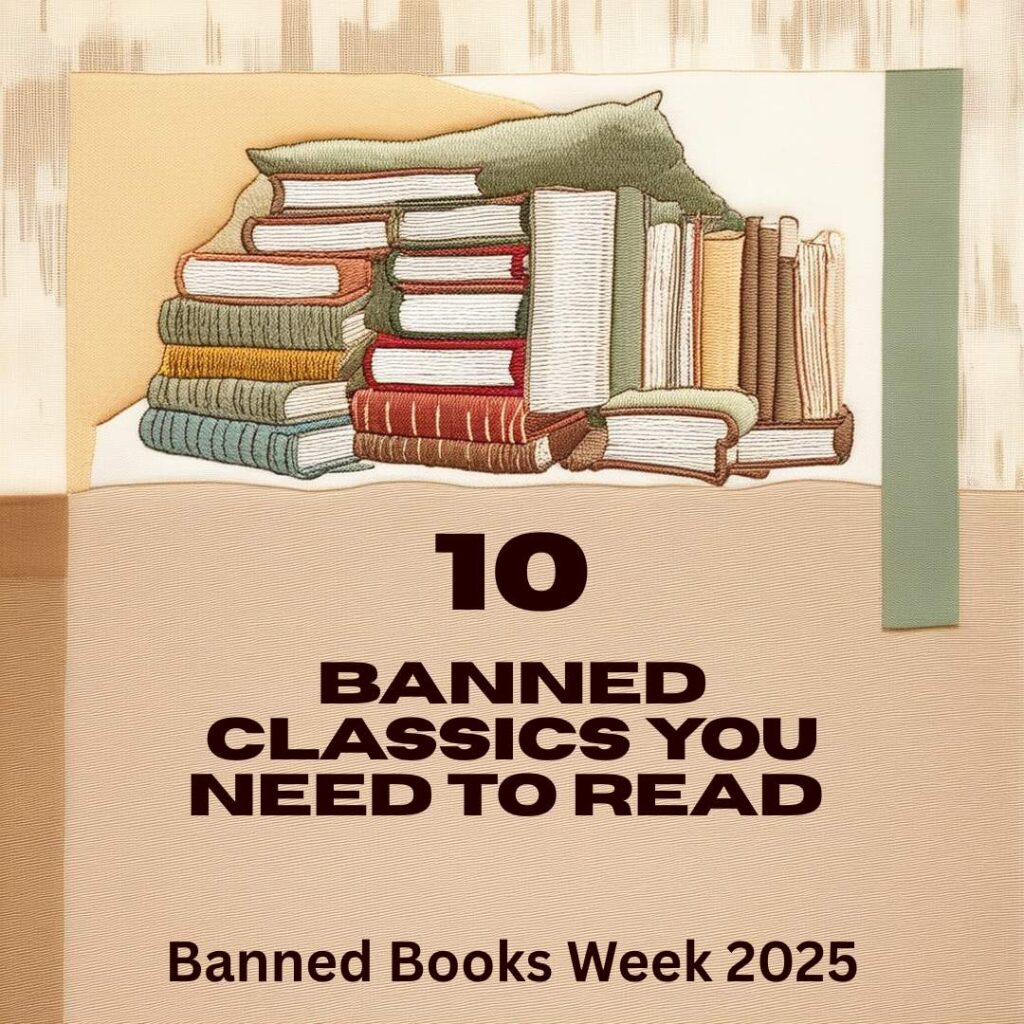10 Banned Classics You Need to Read During Banned Books Week 2025
Books are more than stories. They are voices, memories, and struggles from across time. Yet not all books were welcomed when they first appeared. Many classics faced bans and censorship. Some were accused of being immoral. Others were judged too political or too dangerous.
Banned Books Week, celebrated in 2025 from September 21 to September 27, reminds us of this struggle. It is a week to honor stories that were silenced but refused to die. It is a week to celebrate the freedom to read.
This year’s theme, “Free the Books, Free the People,” highlights how censorship limits voices. It shows why readers must stand for literature that challenges us.
To mark the week, here are 10 banned classics that everyone should read. They are powerful not only for their stories, but for the history of censorship that surrounds them.
Why Banned Books Still Matter in 2025
In 2025, debates over books are louder than ever. Across schools, libraries, and countries, books continue to be challenged. Many titles face restrictions because of their language, themes, or ideas.
Why does this matter? Because banning books is not just about one story. It is about silencing thought itself. When a book is banned, a conversation is cut short. Readers lose the chance to question, reflect, or disagree.
Classics that were once banned are now celebrated worldwide. Their survival shows us that literature is stronger than censorship. Reading them during Banned Books Week is both an act of joy and resistance.
1. Ulysses by James Joyce
When James Joyce published Ulysses in 1922, many readers were shocked. The novel’s open talk about the body, sex, and daily life was considered obscene. The United States banned it for more than a decade. Copies were burned.
In 1933, a landmark court case in New York finally lifted the ban. The judge ruled that Ulysses was not pornography but art. That decision became a turning point for freedom of literature in America.
Today, Ulysses is seen as a masterpiece of modernism. Its stream-of-consciousness style changed how novels could be written. Reading it reminds us of the battles fought so that difficult books could exist.
2. Lady Chatterley’s Lover by D.H. Lawrence
First published privately in 1928, this novel sparked scandal. D.H. Lawrence told the story of an affair between a wealthy woman and her working-class lover. The book was banned for its sexual language and its challenge to class barriers.
In Britain, the ban lasted until 1960, when Penguin Books was put on trial for publishing it. The trial became historic. The jury declared that the novel had literary value, and the ban was lifted.
Today, Lady Chatterley’s Lover stands as a symbol of artistic freedom. It shows how literature can confront both morality and power.
3. The Grapes of Wrath by John Steinbeck
Published in 1939, Steinbeck’s novel tells the story of poor farmers during the Great Depression. It was banned in California, Oklahoma, and other states. Critics claimed it was “un-American” because it showed poverty and injustice too clearly.
Libraries removed it from shelves. Some towns even held public burnings of the book. Yet The Grapes of Wrath went on to win the Pulitzer Prize and later the Nobel Prize for Steinbeck.
Today, the book speaks to new generations facing economic hardship. Its story of survival, struggle, and dignity remains powerful in 2025.
4. 1984 by George Orwell
George Orwell’s 1984 has been censored in many countries since it was first published in 1949. The reason was clear: it is a warning against dictatorship, censorship, and surveillance.
Some governments banned it for being too political. Others banned it for being too anti-communist. Ironically, both sides feared its message.
In 2025, its vision feels more real than ever. In an age of data tracking, AI, and surveillance, 1984 continues to remind us of the dangers of losing freedom.
5. Brave New World by Aldous Huxley
First published in 1932, Brave New World imagines a society built on science, control, and pleasure. It was banned for its talk of drugs, sex, and technology. Schools in America, India, and other countries removed it from classrooms.
But Huxley’s vision was not about promoting those things. It was about warning us what could happen if freedom was traded for comfort.
Nearly 100 years later, in 2025, the book feels prophetic. It pushes readers to ask: What are we willing to sacrifice for stability?
6. The Catcher in the Rye by J.D. Salinger
Since its release in 1951, this story of Holden Caulfield has been both loved and feared. Schools banned it for “bad” language, sexual references, and its tone of rebellion. Some even blamed it for influencing young people in dangerous ways.
Yet many teens found in Holden a voice that understood them. The novel gave shape to feelings of loneliness, confusion, and anger.
In 2025, it remains one of the most challenged books. But it is also one of the most read, proving that young voices cannot be silenced.
7. To Kill a Mockingbird by Harper Lee
This 1960 classic has faced bans for its racial language and its themes of injustice. Some schools argued that its content made students uncomfortable.
But that discomfort is the point. Harper Lee wrote about courage, morality, and racism in the American South. Through the character of Atticus Finch, the novel became a call for justice.
In today’s world, where debates about race and fairness are still alive, To Kill a Mockingbird continues to matter.
8. Fahrenheit 451 by Ray Bradbury
Ray Bradbury’s 1953 novel imagines a future where books are burned and reading is illegal. The irony is that this very book was later banned for its language and themes.
The story is a warning about censorship itself. It shows what happens when people stop questioning and only consume shallow entertainment.
In the digital age of 2025, when screens dominate and censorship still exists, Fahrenheit 451 feels more urgent than ever.
9. The Adventures of Huckleberry Finn by Mark Twain
First published in 1884, Twain’s novel has been praised as one of the greatest American stories. But it has also been one of the most banned.
The main reason is its use of racial slurs. Some schools argued it was offensive. Others believed it could not be taught without context.
Yet Twain’s novel is deeply critical of racism and slavery. It challenges readers to see the hypocrisy of society. In 2025, it remains a complex but essential classic.
10. Of Mice and Men by John Steinbeck
This short 1937 novel tells the story of two friends chasing a dream during the Great Depression. It has been banned for its language, violence, and themes of poverty.
Yet the story is tender as much as it is tragic. It asks hard questions about dreams, dignity, and the human condition.
In 2025, Of Mice and Men is still read widely in schools and book clubs. Its emotional power endures.
Why You Should Read These Books in 2025
Each of these ten books was once feared. Each was silenced in some way. But today, they are studied, loved, and defended.
Reading them during Banned Books Week 2025 is more than a literary act. It is a statement. It says that stories matter. That difficult conversations are worth having. That freedom of thought is too valuable to lose.
Books challenge us to see the world differently. That is why they are banned. And that is why they must be read.
📖 Final Reflection
Banned Books Week 2025 is not just about looking back at censorship. It is about looking forward. The fight for freedom of expression is not over.
When you read Ulysses, 1984, The Grapes of Wrath, or any of these classics, you are not only enjoying literature. You are keeping alive the right to think, question, and imagine.
So this September, pick up a banned book. Let its voice guide you. Let its history remind you that every story matters.
Because when books are free, people are free.



